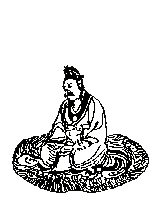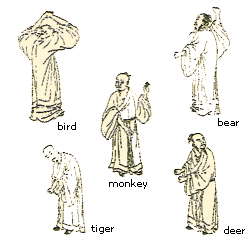Background and History of Qi-gong
The history of qi-gong dates back to about 5000 years. There were many terms given to such kind of exercise before, like xing-qi (promoting the circulation of qi), fu-qi (taking qi), dao-yin (guiding the energy flow), tui-na (exhaling and inhaling), zuo-chan (sitting in meditation), yang-shen (nourishing the spirit) and jing-zuo (sitting still). It was not until 1953, when Liu Gui-zheng published a paper entitled "Practice On Qigong Therapy", that the term qi-gong was adopted widely as a formal name for this type of exercise.
 |
| Manuscript drawing of physical exercises dao-yin (guiding the energy flow) from an ancient tomb of the Han dynasty. |
Qi-gong is thought to have originated as a form of "remedy dancing" created for healing and health preservation purposes. Due to the long-term struggles with nature, the ancients gradually realized that body movements, exclamations, and various ways of breathing could help readjust certain body functions. Qi-gong's development can be divided into four major
 |
| Meditation is important in Taoist practice. |
periods as described below.
Before 206 BC
The period was marked by the Yi Jing (Book of Changes c.1122 BC), the first book to introduce qi (vital energy). Peolpe used the concept of the universe to explain the laws of nature, which is basically the integration of the three natural energies of heaven, earth and man. Studying the relationship of these three powers was the first step in the qi-gong development. During the Zhou dynasty, the founder of Taoism Lao Zi (born in 590 BC), wrote about breathing techniques in his book Tao De Jing(Classic on the Virtue of the Tao). Interest in qi heightened in Chinese medicine's development, and qi-gong became one of the roots of Chinese medicine as well as concepts such as yin and yang and the five elements.
206 BC - 500 AD
During the Han dynasty (206 BC - 220 AD), Buddhist and meditation methods were imported from India, which brought qi-gong practice and meditation into the religious qi-gong era. The religious practitioners cultivated their qi to a deeper level, worked with internal functions of the body, and strove to control their bodies, minds and spirits in order to escape the cycle of re-incarnation.
 |
| Buddhist monks practicing martial arts. |
500 AD - 1911AD
During the Liang dynasty (502-557 AD), it was discovered that qi-gong could be used for martial arts purposes. Many different styles of qi-gong were founded, for example Taichi Nei Dan (Internal Elixir) and Shaolin Wai Dan (External Elixir) exercises. Later in the Qing dynasty (1644 - 1911 AD), qi-gong practices from India, Japan and other countries also became known in China because of improved communication between the countries.
1911AD - present
Qigong has gained higher priority and more rapid development since the founding of the People's Republic of China. Medical workers and qi-gong masters have made efforts to popularize it for health preservation and disease prevention strategies. Scientists study qi-gong in terms of physiology, biochemistry and modern medicine, which has inspired many to learn the tradition. Selective training has now been replaced by more open teaching and research.
 |
| Confucian practice aims at high moral character and intelligence. |
According to the historical background, qi-gong can be classified into five major traditions; Confucian, Buddhist, Taoist, medical and martial arts. Each tradition has its own purpose and different methods of training and practice. The following is a brief description of the major traditions of qi-gong and its applications.
| Traditions |
Intent |
| Medical Qi-gong |
Medical qi-gong emphasizes the free flow and balance of qi (vital energy) in the body. The primary purpose is to treat illness or cure a disease. Medical practitioners learn how to use the inner qi for diagnosis and healing. |
| Taoist Qi-gong |
Stresses preservation of the physical body and high virtue. Many Taoist qi-gong masters enjoyed long lives. (3600 approaches are mentioned throughout its history.) |
| Buddhist Qi-gong |
Aims to liberate the mind, cultivate virtue and to obtain enlightening wisdom. The human body is considered a tool for attaining enlightenment. (84000 approaches mentioned in history; most popular type of qi-gong.) |
| Confucian Qi-gong |
Aims to provide high moral character and intelligence. |
| Martial Arts Qi-gong |
Trains the body for protection from cuts by weapons or attacks using the four limbs. It also trains the body to deliver fatal blows enhanced with qi. |
Among each major tradition, there are various schools of qi-gong that have evolved among the lay pubic. Masters of modern-days qi-gong are still creating new forms. Despite its esoteric origins, no religious belief is required to learn qi-gong. A person may subscribe to a particular school of qi-gong, depending on their needs. All practitioners of qi-gong will enjoy some health benefits, but only medical qi-gong is primarily concerned with the treatment of disease or illness.
 |
| The five animal movements devised by Hua Tuo. Exercises are similar to the movements of the tiger, deer, bear, monkey and bird. |
In Chinese medicine history, many of the famous Chinese medicine physicians were also qi-gong masters. Hua Tuo (141-208 AD) devised movements that were similar to the movements of five different animals: the tiger, deer, bear, monkey and bird. These five animal movements had profound influence on the development of dynamic qi-gong practices. Li Shizhen (1518-1593 AD), a renowned physician and pharmacologist in the Ming dynasty (1368 - 1644 AD), stated in his book, Qi Jing Ba Mai Kao (A Study on the Eight Extra Channels), that "The internal conditions and the channels can only be perceived by those who can see things by inward vision." This famous thesis described the relationship between qi-gong and the meridians. The book became a guidebook for novices in that time. TCM physicians have contributed to qi-gong's development over the centuries making it more practical and widely applicable. It is one of the four main branches of TCM, the others being acupuncture & moxibustion, therapeutic massage & bone-setting, and herbal medicine.
|